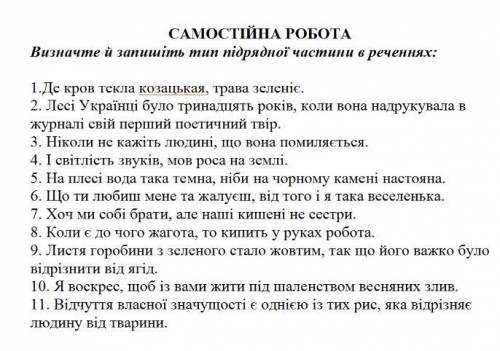Визначте й запишіть тип підрядної частини в реченнях:

Другие вопросы по теме Українська мова
Популярные вопросы
- 2. у пациента перелом 9-10 ребер справа с повреждением органов грудной клетки....
3 - Антон павлович чехов, хамелеон заметки о прочитанном ,, впечатление 35...
2 - Основа рівнобедреного трикутника дорівнює 16 см, а бісектриса проведена до...
1 - Взаимная отвественность родителей и детей перед друг другом по повести пушкина...
3 - Подбери к данным словам по два проверочных: голоса, говорливый, берега, дорогой,...
3 - По россии за 6ой класс 1.2 пораграф выписать все даты...
1 - Выражение а)24×a×4 б)3a×7×b×4×c в)5x+7x г)34a-a д)14m+15m+16 е)12(5a-6) з)7(5x+7y-6a)...
3 - Эссе на тему какую роль играет природа в повести `бедная лиза`...
3 - Синтаксический разбор предложение (и его характеристика) ночью лес полон самых...
1 - Вычислить sin^6 22 градуса 30 минут-cos^6 22 градуса 30 минут...
1
Объяснение:
When you look at two organisms, it is hard to decide by comparing only their
physical characteristics if they are in the same species or not. Two organisms can
look similar but be in different species. For example, cheetah, leopard and jaguar
look similar, but they are three different species. On the other hand, dogs look
different, but they are one species.
For new species to be produced, organisms must undergo reproductive isolation.
It means, they should not be able to interbreed and produce offspring. The
process of formation of new species is called speciation. There are two main
Все учебники Казахстана на OKULYK.KZ *Книга предоставлена исключительно в образовательных целях
согласно Приказа Министра образования и науки Республики Казахстан от 17 мая 2019 года № 217
types of speciation: allopatric and sympatric.
Allopatric speciation
Two organism can be reproductively isolated by geographical barriers. For
example, one part of bird population moves from the mainland to an island. It is
separated from the original population. Here, on the island plants and animals
are different from the mainland. These birds start to adapt to new environment
and change their characteristics. Birds interbreed and over time new generations
become different from the original population on the mainland. These two
populations now cannot interbreed. A new species is formed.
There can be different geographical barriers, for example, large forest can
become split, if part of the trees are cut. So, organisms become isolated from
each other. Speciation when populations are isolated geographically is called
allopatric speciation.
Sympatric speciation
Sympatric speciation is the speciation when there is no geographical barriers.
Organisms are located in one area, but become reproductively isolated.
Polyploidy is the example of sympatric speciation.
Polyploid organism is an organism with more than two sets of chromosomes (3n,
4n, 5n, etc.). It can happen if chromosomes do not separate during gamete
formation. This gametes will be diploid (2n). Then, when these gametes fuse, the
resulting zygote will be tetraploid (4n).
This tetraploid organism can not reproduce sexually, because it is hard to
undergo meiosis and produce gametes. But this organism can easily reproduce
asexually and produce offspring. This offspring can grow and produce a
population of tetraploid organisms. So, the resulting population cannot
interbreed with the original diploid population. They are considered a new
species. Polyploidy mostly happens in plants.